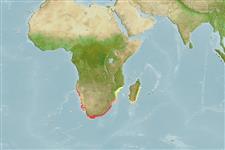Common names from other countries
Environment: milieu / climate zone / depth range / distribution range
पारिस्थितिकी
समुद्री बेनथोपिलाजिक; गहराई सीमा 20 - 150 m (Ref. 27121). Subtropical; 17°S - 36°S
Southeast Atlantic: Namibia (Ref. 27121) and South Africa to Beira, Mozambique (Ref. 3198).
Length at first maturity / आकार / वज़न / Age
Maturity: Lm 20.4 range ? - 26 cm
Max length : 45.0 cm TL पुल्लिंग / अलिंग; (Ref. 3669); common length : 27.0 cm TL पुल्लिंग / अलिंग; (Ref. 3507)
पृष्ठीय रीढ़ (सम्पूर्ण) : 12; पृष्ठीय सौफट रेज़ (सम्पूर्ण) : 10; गुदा कांटा: 3; ऐनल सौफट रेज़: 8. Lips furry.
Found in coastal waters, over soft bottoms (Ref. 27121). Forms large schools (Ref. 5213). Sold fresh.
Life cycle and mating behavior
Maturities | पुनरुत्पत्ति | Spawnings | Egg(s) | Fecundities | लार्वा
Conflicting descriptions of the reproductive style of this species have been reported, e.g., Ref. 34231 describe this species as being a gonochorist (Ref. 28504). After clarificatory analyses on the protogynous characteristics (Ref. 7124) of this species, gonochorism is confirmed (Ref. 103751).
Bauchot, M.-L. and M.M. Smith, 1984. Sparidae. In W. Fischer and G. Bianchi (eds.) FAO species identification sheets for fishery purposes. Western Indian Ocean (Fishing Area 51). volume 4. [var. pag.] FAO, Rome. (Ref. 3507)
IUCN Red List Status (Ref. 130435)
CITES (Ref. 128078)
Not Evaluated
Threat to humans
Harmless
Human uses
मात्स्यिकी: व्यापारिक
साधन
Special reports
Download XML
इंटरनेट स्रोत
Estimates based on models
Preferred temperature (Ref.
115969): 13.4 - 25.2, mean 18.5 (based on 33 cells).
Phylogenetic diversity index (Ref.
82804): PD
50 = 1.0000 [Uniqueness, from 0.5 = low to 2.0 = high].
Bayesian length-weight: a=0.01660 (0.00997 - 0.02764), b=3.05 (2.91 - 3.19), in cm Total Length, based on LWR estimates for this species & (Sub)family-body (Ref.
93245).
Trophic level (Ref.
69278): 3.6 ±0.46 se; based on food items.
लौटाव (Ref.
120179): निम्न, न्यूनतम जनसंख्या दुगनी होने का समय 4.5 - 14 वर्ष। (K=0.13-0.19; tm=6-7; tmax=11).
Fishing Vulnerability (Ref.
59153): Moderate to high vulnerability (47 of 100).
Climate Vulnerability (Ref.
125649): Moderate to high vulnerability (53 of 100).
